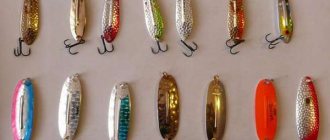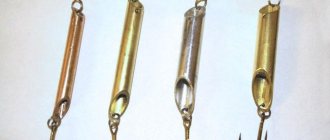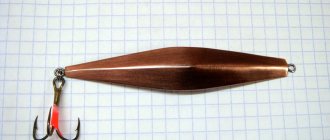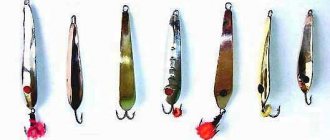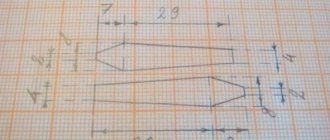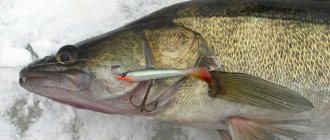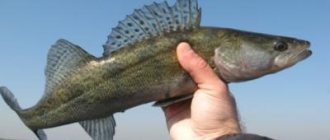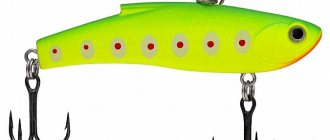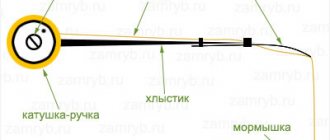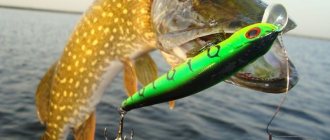Content
- Catching pike perch in winter with a spoon requires skill.
- Pike-perch on lures in winter - video for beginners
- The best lure for pike perch – what is it?
- History with geography What lures for pike perch America offered
- What do Scandinavians use to catch pike perch in winter?
- The best spinners “originally from the USSR” - do it yourself
- 1. Noisemaker tube
For those who are just discovering fishing for pike perch with lures in winter, it is quite difficult not to get confused in needles and pimples, tubes and trapezoids, Williams and admirals and decide for themselves which ones are better. In addition, it is not enough to buy and tie a spoon, you need to know how to fish with it in certain conditions, and this only comes with experience.
In this article, we set the task of giving a general description of the variety of winter lures for pike perch so that the words “castamaster”, “maropedka”, “pike perch”, “uchinskaya”, etc., form a coherent picture in the mind of a novice fisherman, and for an experienced fisherman - The zander fisherman had something to add in the comments to further clarify the specifics of fishing with this or that piece of oblong metal.
So.
Photo by user of the site FishingSib.ru Lech-154 “Bite”
Nurse
Another representative of the most catchy winter lures for fanged predators.
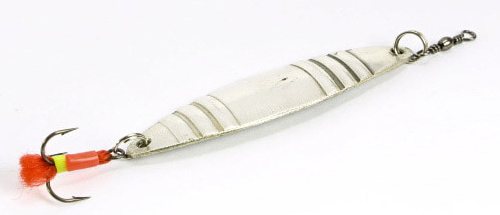
- What it looks like. This is a narrow, slightly elongated spoon, in which longitudinal cuts and a slight transverse bend are visible.
- What is it made of? Brass.
- Dimensions. The thickness of the bait is about 2-2.5 mm. Length – 7.5-8 centimeters.
- Weight. 16-17 grams.
Due to its shape, the game of this bait, just like the previous one, resembles the movements of a wounded fish. The bait goes to the bottom “waddling” from side to side.
Catching pike perch in winter with a spoon requires skill.
When catching pike perch in winter (with a spinner, a balancer or a vib, it doesn’t matter) the first difficulty is finding it. To do this, you need to know the fishing area, the places where pike perch prefer to stand, and be prepared to move a lot and drill a lot. Let's say a fish site has been discovered. In this case, experienced pike-perch fishermen leave the ice with their catch, but beginners still often end up without taking into account a number of nuances. In particular, sluggish pike perch prefers low-amplitude play and often bites during pauses. This determines the choice of both bait and wiring.
A typical retrieve when catching pike perch with a vertical spinner is a short throw - within 30 cm, and a long pause, which can reach 15 seconds. And monotonous, stable repetition of movements. But as for the specifics - speed, throw height, pause length - there can be no clear instructions, everything is selected intuitively and experimentally and comes only with experience.
Each pike perch bait has its pros and cons. Why do many fishermen prefer to catch pike perch in winter with a spoon rather than with a balance beam? Because, firstly, the main food of pike perch - small fish - when feeding, is located vertically, and the spoon, unlike the balancer, looks more natural in this light. Secondly, spinners can have a more varied game, and not just horizontal amplitude fluctuations.
Tackle
For winter fishing for pike perch with spoons, you will need to choose the right gear. They usually consist of the following components:
- whip;
- coil;
- nod;
- fishing line;
- treble hook.
The whip on the fishing rod should be strong and rigid, from 40 cm to half a meter long. The predator has a strong palate; you can only land it on a hook with a strong and biting hook. Short telescopic fishing rods measuring 50cm work well. They are durable, lightweight and easy to use.
The reel should be easy to handle so that line can be easily spooled in and out. The type doesn't matter. Inertial and inertial-free models have proven themselves well. Experienced fishermen say the most effective is a multiplier reel, which is perfect for catching pike perch. It is not only powerful, but also universal, because... allows you to work with heavy-duty fishing rods and large-sized lures.
The nod is used at the discretion of the angler. It should be metal or made of lavsan, 4 to 6 cm long. Effective together with light bait in shallow water. With it, the play of the spoon looks natural and attracts the attention of predatory fish.
A line for catching pike perch needs to be strong and inextensible, preferably monofilament. If it stretches at a significant depth, it will not allow you to make a good hook. Braided fishing line is also suitable. Thickness – not less than 0.2 and not more than 0.4 mm. In winter, pike perch is very careful and, when it sees a thick line, will move away from the bait.

Triple hooks are usually used, because... pike perch often disappear from a single fish. It’s better not to save money and buy expensive, but high-quality ones, so as not to return home without a catch.
Leash. This element of equipment is usually not required when fishing for pike perch. It is relevant only if pike is caught in the reservoir. Otherwise, you should not install it, because... it worsens the performance of the spinner.
The best lure for pike perch – what is it?
Form . Definitely narrow and oblong. This is exactly what the ideal lure for pike perch in winter should be. As is the pike perch food supply. Because the mouth of the fanged one is not particularly wide.
Weight . Opinions on this matter differ significantly. Range - from 5 to 30 g. Such a wide corridor has an explanation - the choice of the optimal weight in each specific situation is influenced by: the shape of the spoon and its “behavior” when falling, the fishing depth, the presence of a current, the season (first ice, deep winter or spring).
Length – from 5 to 10 cm. It is believed that baits exceeding these dimensions may interest winter pike perch to a lesser extent.
Color . It is widely believed that the best lure for pike perch in winter is silver.
Another important point in successfully catching pike perch is the sharpness of the hook, since the fanged mouth is strong, and bites in winter are often weak and delicate.

Photo by FishingSib.ru website user NikolaiM from the news “Be on trend!”
Playing technique
Each fisherman has his own technique for catching pike perch in winter using a spoon. Regardless, there are a number of general rules that must be followed in order to be successful.
The fishing of pike perch in winter begins with the bait hitting the bottom. This action raises turbidity and attracts the attention of a predator. It also allows you to study the differences and bottom topography. This is followed by a short pause of up to 15 seconds, after which the spoon needs to be raised up by 30-40 cm. Take another pause, smoothly lift the bait up another 35-40 cm, and then sharply lower it down. This cycle of actions must be repeated every 5-15 seconds.
In the process of vertical flashing, pauses play a key role. At this time, the bait simply hangs in the water, swaying slightly. It is at such moments that the pike perch attacks her.
The height and speed of ascent, the duration of pauses are values that need to be established experimentally. It happens that in the same place on different days, pike perch behave differently. The actions differ for different baits. You need to practice with each of the available ones in order to understand how they behave, what kind of game they show, what movements of the spoon lead to bites.
It’s not worth staying on one hole for a long time, trying to attract the attention of a predator. If after 5-10 cycles of moving the spinner there is no result, you can move on to another hole.
Pike perch is very rarely found at the very bottom. It is best to catch this fish at a depth of about 2 meters. But you need to start playing with bait from below in order to raise the dregs and attract his attention. The bait moves upward gradually, in steps; after each throw there must be a short pause. A longer one is allowed only at the top point.
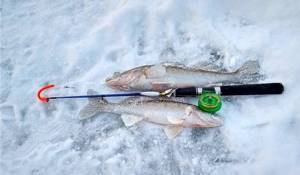
To guarantee results, you will need to determine what the predator eats. To do this, after catching the first fish, you should gut it and check it. If there are gobies, ruffs or minnows in it, then the spinner needs to be played actively, often hitting the ground and raising the turbidity. If a bleak is detected, then the bait is hit on the bottom only at the initial stage. In this case, it is correct to catch pike perch in the upper layers of water, where it is actively looking for food.
History with geography
In world fishing, three main branches of development of metal baits for winter pike perch can be distinguished, which have certain common features. This is an American, Scandinavian direction and what we can conditionally call “originally from the USSR.”
What lures did America offer for pike perch?
The Acme company can be considered the ancestor of American spinners working for winter pike perch. It was she who put into production the famous Kastmaster , developed in the 50s of the last century by Art LaValle and which became a household name denoting a specific type of spinner - a cylindrical blank, cut at the top and bottom at certain angles (17° and 23°).
Another authentic American product is the “ Swedish Pimple” from Bay De Noc, which has been produced for over 50 years. The spinner is cast, has a smooth or pimpled surface, is available in various colors, and is shaped like an oblong petal. It is considered to be excellent for fishing on the first ice and in the dead of winter.
We owe the appearance of the Williams Ice Jig spinner to Canadian designers , a feature of which is the presence of two soldered hooks, supposedly reducing the number of derailments. We will hardly find particularly enthusiastic reviews of this bait from domestic fishermen, but many emphasize its versatility.

In the photo from left to right are spinners from the American continent: castamaster, Swedish pimple, Williams ice jig
What do Scandinavians use to catch pike perch in winter?
There is an opinion that Scandinavian winter lures for pike perch are not particularly suitable for catching large fish. However, these lures are well designed and designed for a wide range of fishing conditions. A specific feature of most Scandinavian spinners is that they are equipped with hooks on a hanging chain. Accordingly, when retrieving, pauses of 10 seconds or more are desirable to avoid the hook getting caught in the fishing line. The Scandinavians, namely the Finnish company Puustjärven, gave the world fishing such famous pike-perch spoons as Alaska, Hopeasiipi and Veteran.
Alaska is considered a classic. A long, voluminous metal plate is flat on one side and has a convex hump on the other. When planning freely, maintaining the horizontal, it seems to flutter from side to side.
Hopeasipi (translated as “silver wing”) has the shape of an elongated triangle and intense play with sweeping oscillations and wagging of the tail. The unusual pronunciation of the word “hopeasipi” has led to the fact that this lure is popularly called hipisipi, hopea and even hipipisya. You need to get used to handling this bait in every sense.
Veteran is another type of pike perch lure. Unlike the Scandinavians mentioned above, it has wings that allow the polished piece of metal to make not so much oscillations under water as wide gliding movements and diving.
Note that this is not the entire list of catchable pike-perch Scandinavian baits, but, perhaps, their main types.

In the photo, from left to right, Scandinavian spoons: Alaska, Hopeasipi, Veteran
The best spinners “originally from the USSR” - do it yourself
They were called mainly either by the name of their inventors, or by their form. The most famous include Vlasovskaya, Uchinskaya, Matveychikov’s spinner, Maropedka, V.A. Cobra. Yudenko, Sabanuev triangular (coffin, trapezoid). We also have a fairly wide range of homemade spinners, the roots of the invention of which we have not been able to reliably restore. Among them: hexagon (impeller), tube, beam, boat, needle, nurse, curved knife, clove, pike perch, etc. There are really a lot of varieties.
Perhaps the only domestic spinner produced in the USSR industrially and working on pike perch in winter is the famous heavy Atom, born in the 50s. last century. Although it can be considered more as a bait for pike. By the way, the workers dubbed it “Atom”, seeing an external resemblance to an atomic bomb.
In order to immediately prevent any disputes arising regarding the correspondence of the picture to the title, let’s say that often different authors and sources (including authoritative ones) attach completely different images to the same names. For example, under the guise of the “famous Vyatka spinner” we will also find S.M. Muravlev model 1917, and what we know as the “pipe”.
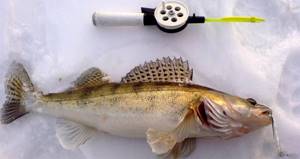
Photo by FishingSib.ru website user NikolaiM from the news “Launch of the Kite”
The Vlasov spinner (I.M. Vlasov’s spinner) turned 70 years old this year - its drawings were first published in 1949 in the anthology “Fisherman-Sportsman”. Now the idea of the original form is, if not lost, then significantly blurred. The only obvious thing is that it should be oblong, “have a noticeable transverse steepness and a slight longitudinal bend.” The game should be smooth, then it moves diagonally, oscillating finely. Just what passive fish need.
The shape of the Uchin spinner was described back in the 50-60s. last century, received its name from the Uchinsky reservoir. Characterized by active play, good for finding fish. Made from a combination of cupronickel and brass. It is often recommended for novice fishermen and when fishing at depths of 4 to 8 m.
Vladimir Matveychikov's spinner is well known in the world of sport fishing. It works best at a depth of 1.5 to 5 m. Despite the simplicity of the form (you can easily make it yourself), it is characterized by stable play - moving to the side with swaying sides.

In the photo from left to right: Vlasov spinner, Uchinskaya spinner, Matveychikov spinner
Maropedka was born as an attempt to make a copy of Matveychikov’s spinner, but the inventor (A. Vorobyov) was unable to repeat the exact author’s bend, so the result was a mix of Matveychikov’s spinner, Rhombus and torpedo – Maropedka, which showed itself as a catchable bait, for which they work as short and sharp strokes, and smooth discharges.
Kobra V.A. Yudenko , in the opinion of its author, combines oscillations without rotation, buoyancy at a certain rate of movement and vibration of the tail section. All this increases catchability and protects the fishing line (cord) from twisting.
Needle , another winter lure for pike perch among the catchy home-made products, opens up in skillful hands. There are overlaps, but if you choose the wiring, it works smoothly. Pike perch, perch and pike bite on it. True, it is not suitable for shallow depths up to 2 m.

In the picture from left to right: Maropedic, Cobra, Needle
The tube (flute) is a steel or brass tube with the ends cut at an angle: at the tee - 60°, at the top - 30° (or according to other sources, 30° and 45°, respectively). Today they are hollow, sealed and composite. Well suited for beginner fishermen.
The author of the trihedron (coffin, trapezoid) is considered to be the famous former Leningrad spinning player Viktor Sabunaev. In addition to Sabunaev’s version, there were others, but it was this master who introduced the “gold standard” of the bait.
The hexagon (impeller) is one of the most “ancient”, simple and widespread types of spinners until recently. It is distinguished by its relatively large weight and monotonous play. When falling, it moves slightly, but due to its large weight it creates long-damping vibrations, which can provoke a passive predator.

In the picture from left to right: tube, trihedron, twisted hexagon
Types of spinners for catching pike perch vertically
This is not the entire list of pike perch spinners. There are such well-known homemade products as a needle, a ray, a nail, a boat, a nurse, a pike perch... There are so many of them, how to figure them out? For this, in fact, it is important to know that all pike-perch spoons are divided into three types.
A jig is a heavy, narrow-bodied spoon bait designed for fishing at great depths. Initially developed for sea fishing. The classic proportions of length and width are 6:1. It is believed that jigs do not have any pronounced independent play as such. Therefore, they are quite easy to learn and are well suited for beginner fishermen. Also, due to moderate oscillatory movements, they are used on passive fish. We will conditionally classify as jigs: Kastamaster, Alaska, Vlasovskaya, Uchinskaya spoons, tube, hexagon, needle, nail, nurse, boat. As you can see, this category is numerous.
The loose material floats slowly, as if crumbling to the bottom. The center of gravity, as a rule, is located almost in the center, due to which the spoon does not fall, but trembles, slowly descending. Such lures include the Swedish pimple, Hopeasipi, trihedron, beam, Matveychikov's spoon, Maropedka and pike perch.
The gliding spoon actively deviates from the vertical, due to which it is able to fish a fairly wide area of water and attract a larger number of predators. Classic gliding lures are Williams Ice Jig, Veteran, Cobra and Atom.

In the photo from left to right: a typical jig, a loose jig (beam) and a planning spoon
How will this classification help us? Very simple. Now we have a general idea of what bait geometry leads to what underwater behavior - docile or expressive-dynamic. And when choosing a spinner, we know that:
- firstly, the more complex the movement of the bait underwater, the more difficult it is to animate it effectively;
- secondly, the more passive the fish, the calmer the behavior of the spoon should be;
- thirdly, the more actively the bait moves, the larger the water area under the ice you can fish, which is good when searching for fish.

Photo by FishingSib.ru website user NikolaiM from the news “The heat has gone!”
The next question is - from what is described above, what kind of spoon can you buy and catch? That is, what is the actual TOP of the best lures for pike perch?
Features of equipment for trolling pike perch in winter
The bait should be equipped based on the features of the fish you will have to catch. For example, pike perch weighs about 3 kg. (in rare cases more), and the choice of gear must be selected responsibly, so as not to regret later that the fish was missed.
Fishing rod. Its length should be about 80 cm with a hard whip capable of supporting the weight of the fish. The handle should not cool in the cold, so it must be selected from cork material.
Coil. Must be durable and cope with quick winding of fishing line. The type is not important here, and if there is a multiplier, then this will allow you to easily pull out the predator during fishing.
Fishing line. It should not be made of braided cord, which freezes in the cold and gets tangled. It is better to select the diameter from 0.2 to 0.35 mm. - it all depends on the size of the fish that the angler expects to catch. Monofilament would be an excellent choice. In addition, it prevents the line from stretching when the predator jerks during a bite.
By the way! Thick fishing line often scares away fish when they bite.
Nod. In principle, pike perch can be caught both with and without a nod. If, nevertheless, someone decides to use a nod, then it should be selected about 5 cm from a metal plate. It will be needed if fishing takes place in shallow areas of the reservoir, so that the game seems natural. The main thing is that the nod must be elastic.
TOP 10 - the best lures for pike perch
Compiling any rating, and especially rating lures, is a rather thankless task; the choice of a particular angler is very subjective. The numbers under which baits are listed do not at all indicate their level of popularity. This is simply a numbering adopted for ease of presentation.
Our rating included spinners such as jigs and loose lures, produced industrially ( not homemade ) and falling into the conditionally budget range - up to 500 rubles (with the exception of the odious “pimple”). Perhaps we have overlooked something. Be sure to write about it in the comments.
Noisemaker tube
You can buy it, or if you have some skill, you can make it yourself. Simple, proven, famous. It is with a noisemaker tube that beginners often begin to master the winter pike-perch spinner. Classic jig.
ECOPRO Shprot
This spinner, relatively new in the model range of the St. Petersburg company ECOPRO, is rapidly gaining popularity. Fishing store sellers say that more and more people are coming to them specifically for sprat.
Halco Twisty
“Halka” has long been considered a classic of winter pike perch fishing. The original from Twisty is reliable, proven, and 100% catchable. By the way, the spinner is Australian. It belongs to the dry type and has a very interesting game.
ECOPRO Alaskan
This spoon is a duplicate of the famous Scandinavian Alaska. Like many replicas from ECOPRO, it showed its good side. Our Alaska is accessible - both in price and in availability in stores, unlike true Puustajarven. And at the same time he catches himself quite well.
Admiral zander
This spoon is more popular in the European part of our country, it is considered a jig, comes in all sorts of colors and is available in a wide range of weights. The Admiral behaves steadily in the current and at the same time is very affordable.
Sudakovaya
Another budget jig with nickel silver, coated with phosphor, which is great for attracting pike perch under the ice. The pike-perch spinner from the series is cheap and cheerful, easy to use, suitable for beginner anglers, a must-have, in general.
ECOPRO Sudachya
This St. Petersburg powder on our reservoirs can rightfully be considered a classic. Many anglers have zander from ECOPRO in their arsenal and successfully fish with it.
Bay De Noc Swedish Pimple
The same “Swedish pimple”. Yes, it’s not cheap - the original costs more than 500 rubles, USA, whatever you wanted. But absolutely catchy. Although I can’t say that it’s particularly easy to use.
KOI Striped Iceberg
An imported derivative of the trihedron-bulk originating from Japan. The shape allows it to be used not only as a vertical spinner, but also for horizontal fishing. By the way, KOI Striped Iceberg is forged.
Nord Waters Nirvana
In our country, craftsmen make analogues of Nirvana of the Northern Waters from old tweezers. The ribs on it are designed for hydroacoustic effect. Not to say that it is particularly popular in wide circles, but it catches pike perch perfectly. The price is average.
Many of the domestically invented spinners mentioned in this article can be made with your own hands if you wish, or you can turn to those who already do it well.
We hope you found the material useful or at least informative. We are waiting for your additions to our vision in the comments to the article!
